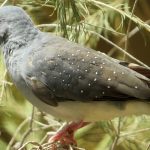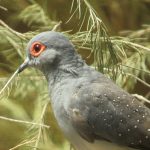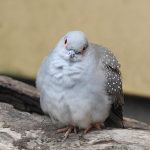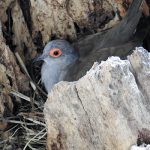DIAMOND DOVE
The Diamond Dove: A Sparkling Gem Among Australia’s Birds
| Aspect | Details |
|---|---|
| Size | 18–20 cm (petite, even for a dove!) |
| Plumage | Light blue-grey head and upper body; wings/tail adorned with delicate white spots |
| Eye Rings | Bright red-orange (like a splash of chilli on fine china) |
| Native Range | Across northern and central Australia—adapting to arid and semi-arid landscapes |
| Habitat | Grasslands, open woodlands, scrublands, gardens, even city parks |
| Social Bonds | Highly social; often found in pairs or small groups; generally peaceful |
Feeding and Foraging
- Diet in the Wild:
- Mostly seeds (especially of native grasses)
- Occasional small insects (protein snack, anyone?)
- Grit—essential for their digestion (their version of “teeth”)
- Captive Diet Recommendations:
- Millet, canary seed, finch mix
- Fresh greens and the odd fruit treat
- Always clean water and a pinch of grit to help grind those seeds
Breeding: Adaptation in Action
- Rainfall as Cupid:
Rather than sticking to the clock, diamond doves breed after heavy rains—ensuring food and water for their fluffy offspring. - Nesting:
- Dainty, see-through nests perched low in shrubs or open trees.
- Both parents religiously take turns warming the eggs—no absentee parenting here!
- This tag-team effort gives their young the best chance in a land not known for forgiving weather.
Unveiling the Broader Significance
- Resilience & Flexibility:
Rain-driven breeding cycles highlight how diamond doves have become climate-adaptive masterminds, a handy blueprint for surviving Australia’s unpredictable seasons. - Conservation Message:
By maintaining healthy grasslands, bushlands, and even bird-friendly urban spaces, we’re not just helping diamond doves—we’re preserving the rich symphony of Australia’s native avifauna.





